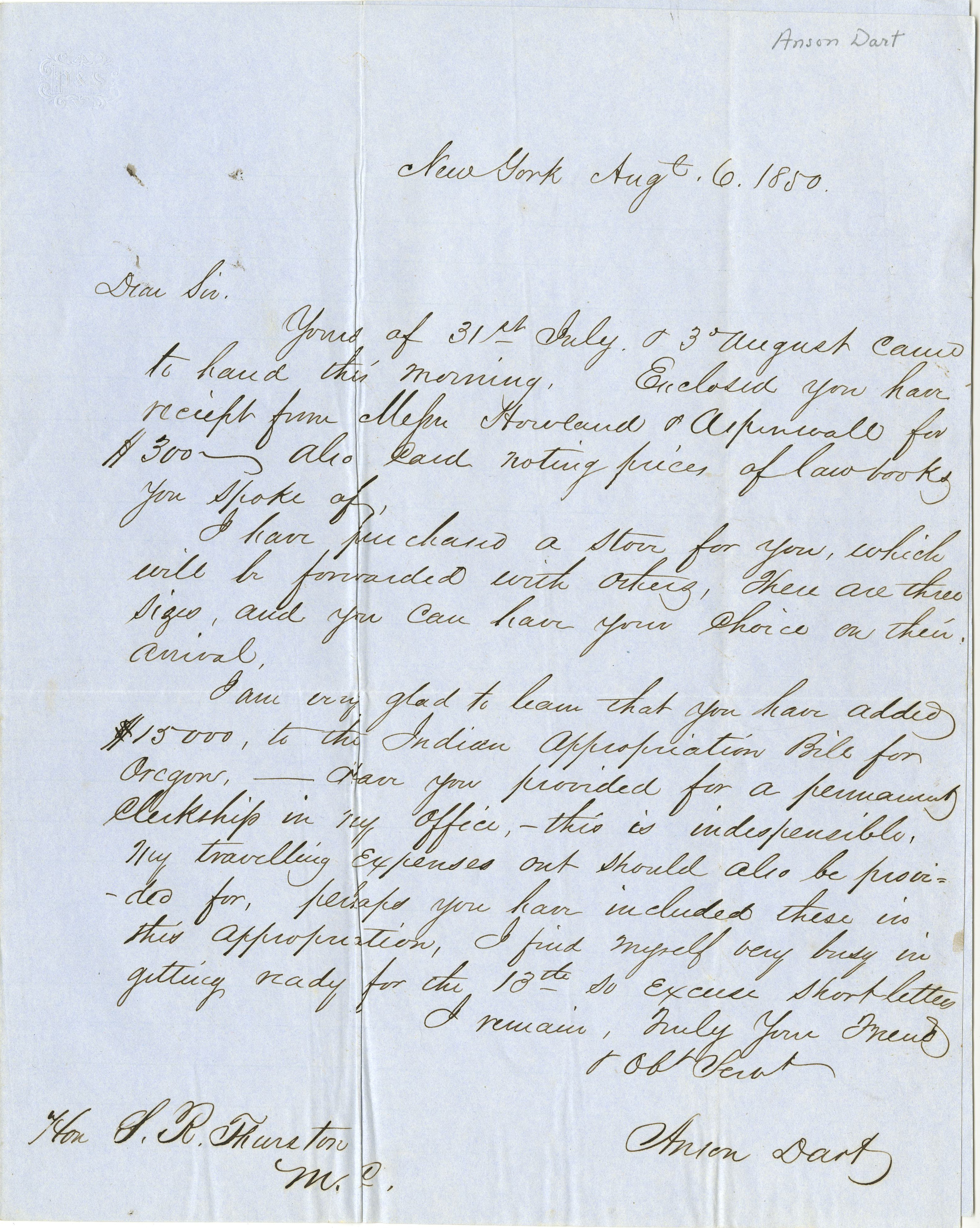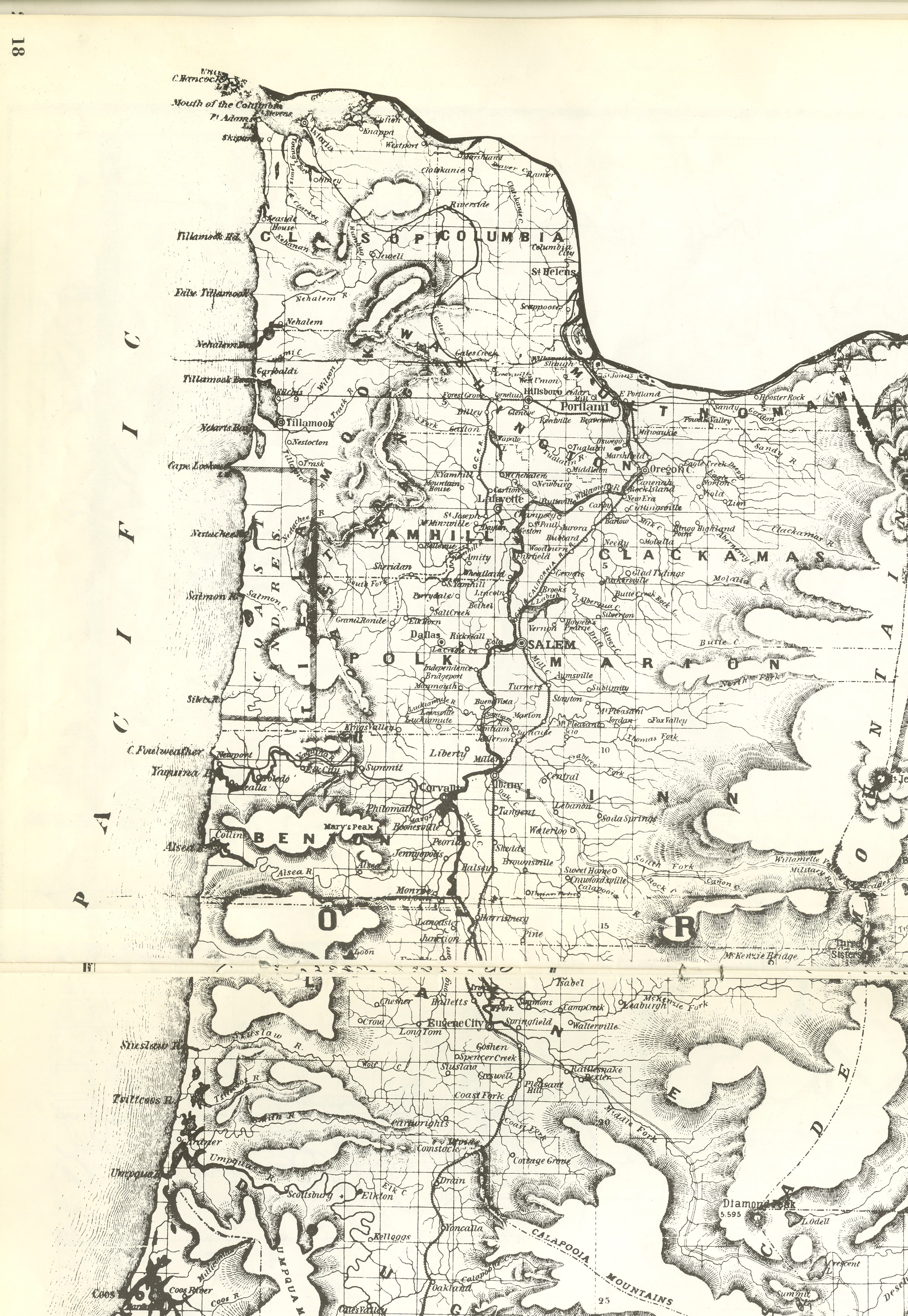On June 5, 1850, An Act Authorizing the Negotiation of Treaties with the Indian Tribes in the Territory of Oregon, for the Extinguishment of their Claims to Lands Lying West of the Cascade Mountains was passed into law. The act established a commission to negotiate treaties with western Oregon Indians for the purpose of extinguishing all Indian claims to lands west of the Cascade Mountains and removing over two thousand members of thirty tribes to a reservation east of the mountains.
Almost two years earlier, on August 14, 1848, Congress had passed the Act to Establish the Territorial Government of Oregon, which protected the rights of “Indians in said Territory, so long as such rights shall remain unextinguished by treaty”; appointed the governor to serve as superintendent of Indian Affairs; and appropriated $10,000 for these purposes. When the Oregon Territory was established on March 2, 1849, newly appointed Governor Joseph Lane assumed control of Indian Affairs, but he resigned before he was able to organize treaties with the tribes of western Oregon. John P. Gaines was named governor in 1850.
Samuel Thurston, territorial delegate to Congress in 1849-1851, lobbied for the removal of the western Oregon Indians to east of the Cascade Mountains to further enable settlement in the Willamette Valley. Thurston was largely responsible for the Donation Land Claim Act of September 27, 1850, and orchestrated these congressional actions to comply with the Indian Intercourse Act of 1834 and to clear Native title to the land before implementation of the Donation Land Claim Act.
An act passed by the territorial legislature on June 5, 1850, made the superintendent of Indian affairs for the territory a separate position from that of governor. In July, Dr. Anson Dart was appointed as superintendent of Indian Affairs for the Territory of Oregon. He was informed that “the object of the government is to extinguish the title of the Indians to all the lands lying west of the Cascade Mountains.” Additionally, Dart was instructed to suppress the whiskey trade and to encourage Indians in agricultural pursuits and the work of Christian missionaries.
The Willamette Valley Treaty Commission, appointed in June 1850, consisted of Governor Gaines, Alonzo A. Skinner, and Beverly S. Allen. Gaines, the representative of Kentucky in the U.S. House from 1847 to 1849, was a supporter of President Zachary Taylor, who had appointed him governor. Skinner, who had arrived in Oregon in 1845, was circuit judge for the Provisional Government from 1846 to 1849. Beverly S. Allen received his commission in August 1850 and arrived in Oregon in February 1851.
In October 1850, the commission received its directive from the Office of Indian Affairs: to meet with the Indians of the Willamette Valley, to treat with each tribe separately, and to determine the quantity of land ceded and the price per acre to be paid. The value of the ceded lands was to be allocated in annuities paid by goods. In addition, the treaties were to provide for agricultural assistance, blacksmiths, physicians, and teachers. In all, $20,000 was appropriated for these purposes, $5,000 of which was to be invested in goods. The commission was directed to negotiate with all of the tribes separately and to focus on the Willamette Valley first; it would meet with only four bands of Kalapuya and two bands of Molala.
The Willamette Valley Treaty Commission met at Champoeg with the leaders of the Santiam and Tualatin Kalapuya from April 11 to April 19, 1851. Treaties were signed with the Santiam on April 16 and with the Tualatin on April 19. The records of the negotiations show the difficulty the commission had trying to induce the Kalapuya to accept the provisions of the treaty, in particular the requirement that tribes be removed to a reservation east of the mountains.
The commission met again at Champoeg with the Yamhill and Lakmiut Kalapuya and the Molala and Santiam Molala from April 24 to May 7, 1851. Treaties were signed with the Lakmiut and Yamhill on May 2, the Principal Band of Molala on May 6, and the Santiam Molala on May 7. By this time the commission had become convinced that tribes would not accept removal to east of the mountains. They agreed, however, to land cessions, and reservations were proposed in the Willamette Valley.
The treaties were then forwarded to the commissioner of Indian Affairs for submission to Congress. In the accompanying documents, Governor Gaines explained that the Kalapuya and Molala had refused to abandon their ancestors’ graves; they were unaccustomed to procuring a livelihood in the dry eastern country; and they would rather have the whites exterminate them in the Willamette Valley than move east of the Cascade Mountains. The Tualatin leader Kiacut explained that while it might be in their best interest to move, the Tualatin had made their home in the Willamette Valley for a long time and did not wish to leave. Santiam leader Alquema said: “it may be better for us, but our minds are made up. We wish to reserve this piece of land….We would rather be shot on it than to remove.”
In October, the commissioner of Indian affairs reported that Congress had dissolved the Willamette Valley Treaty Commission and their duties were abrogated. The responsibility for future treaties would go to the Oregon superintendent of Indian Affairs to continue the work alone. Anson Dart negotiated thirteen more treaties with western Oregon tribes, including the Chinook, the Willapa, the Tillamook, and the Clackamas.
In October 1852, the commissioner of Indian Affairs informed Dart that Congress intended to reject the treaties and he should make no more. The treaties languished for another two years until finally, after some consideration by the U.S. Senate, they were effectively rejected through neglect, the rationale being they were made with “insignificant tribes” and contained “no apparent restrictions.”
In all, twenty-four unratified treaties were negotiated with the Indians of western Oregon, including the six negotiated by the Willamette Valley Treaty Commission. The Kalapuya and Molala bands party to negotiations with the commission finally got a treaty in 1855 when Congress ratified the Treaty with the Kalapuya, etc.
-
![]()
Champoeg, sketch by George Gibbs, 1851.
Courtesy Oregon Hist. Soc. Research Lib., 002924
-
![]()
Joel Palmer, c.1860.
Courtesy Oregon Hist. Soc. Research Lib., OrHi362
-
![]()
Alonzo Skinner, 1845.
Courtesy Oregon Hist. Soc. Research Lib., 002535
-
![]()
Gov. John P. Gaines.
Courtesy Oregon Hist. Soc. Research Lib., OrHi9180
-
![]()
Letter from Anson Dart to Thurston, Aug. 6, 1850.
Courtesy Oregon Hist. Soc. Research Lib., Mss379, folder 3
-
![]()
Samuel Thurston.
Courtesy Oregon Hist. Soc. Research Lib., 020665
-
![]()
Spirit Mountain, 1904.
Courtesy Oregon Hist. Soc. Research Lib., 019372
Related Entries
-
![Anson Dart (1797-1879)]()
Anson Dart (1797-1879)
In 1850, Anson Dart (1797-1879), of Wisconsin, was appointed as the fir…
-
![Confederated Tribes of Grand Ronde]()
Confederated Tribes of Grand Ronde
The Confederated Tribes of Grand Ronde Community of Oregon is a confede…
-
![Kalapuyan peoples]()
Kalapuyan peoples
The name Kalapuya (kǎlə poo´ yu), also appearing in the modern geograph…
-
![Kalapuya Treaty of 1855]()
Kalapuya Treaty of 1855
The treaty with the Confederated Bands of Kalapuya (1855) is the only r…
-
![Molalla Peoples]()
Molalla Peoples
The name Molalla ([moˈlɑlə, ˈmolɑlə], usually spelled Molala by anthrop…
-
![Oregon Donation Land Law]()
Oregon Donation Land Law
When Congress passed the Oregon Donation Land Law in 1850, the legislat…
-
![Walla Walla Treaty Council 1855]()
Walla Walla Treaty Council 1855
The treaty council held at Waiilatpu (Place of the Rye Grass) in the Wa…
-
![Willamette Valley]()
Willamette Valley
The Willamette Valley, bounded on the west by the Coast Range and on th…
-
![Willamette Valley Treaties]()
Willamette Valley Treaties
From 1848 to 1855, the United States made several treaties with the tri…
Related Historical Records
Map This on the Oregon History WayFinder
The Oregon History Wayfinder is an interactive map that identifies significant places, people, and events in Oregon history.
Further Reading
Annual Report to the Commissioner of Indian Affairs. Washington, D.C.: U.S. Government Printing Office, 1850-1851.
Beckham, Stephen Dow. “We Do Not Want Any Other Piece of Land.” Oregon Indians: Voices from Two Centuries. Corvallis: Oregon State University Press, 2006.
Coan, C.F. "The First Stage of Federal Indian Policy in the Pacific Northwest, 1849-1852." Oregon Historical Quarterly 23.1 (1921): 46-89.
Gibbs, George, and Edmund Starling. Sketch of the Willamette Valley showing the purchases and reservations made by the Board of Commissioners appointed to treat with the Indians of Oregon, April and May 1851. Prepared by George Gibbs and Edmund A. Starling. National Archives, Washington, DC., 1851.
O’Donnell, Terence. An Arrow in the Earth: General Joel Palmer and the Indians of Oregon. Portland: Oregon Historical Society Press, 1991.
Spores, Ronald. "Too Small a Place: The Removal of the Willamette Valley Indians, 1850-1856." American Indian Quarterly 17.2 (1993): 171-192.
Records of the Oregon Superintendency of Indian Affairs. File Microcopies of Record in the National Archives: No. 2, Roll 28. Records Pertaining to Relations with the Indians. National Archives, Washington, D.C., 1944.
















